One dyadic station shopping head elects
« previous post | next post »
Somebody sent me this sign from a supermarket in China:
Yí zhàn shì gòuwù de shǒuxuǎn
一站式购物的首选
One dyadic station shopping head elects
This is one of the most bizarre specimens of Chinglish I've ever encountered.
If we omit "dyadic", the rest of it is easy to figure out (it should be "First choice for one-stop shopping" — no sweat). Usually, even when a translation is incredibly peculiar, it doesn't take me long to figure out where the translator (whether human or machine) went wrong. In this case, "dyadic" is so unusual, yet so specific, that I figured it must have had some basis, otherwise the translator would not have gone to the trouble of inserting it out of thin air (pingkong 凭空).
I was hooked. I had to figure out where "dyadic" came from.
Of course, it's possible that the individual who sent this sign to me copied it incorrectly. But what would have prompted him to add such a rare, technical term? Furthermore, from other things that he talked about in his message and his manner of writing, I could tell that he was by nature a careful person.
Normally, I don't write about such matters without photographic documentation or an "obligatory screen shot", yet in this case I was so intrigued by "dyadic" that I quickly began to formulate various hypotheses and do research in support of them or to disprove them.
Meanwhile, although I did not directly impose on my correspondent by asking him to go back to the store with a camera or cell phone (he didn't have one the day he spotted the sign and copied it), I did hint that it would be helpful if I had one, and I did ask him a number of questions to flesh out some of the information he had initially sent to me (just that it was from a supermarket in China). (Let this be a tutorial for how to decipher Chinglish, if you're interested in becoming proficient at it.)
Here's what I asked:
1. what was the full name of the store?
2. was everything in the store you went to inexpensive?
3. what province / city / town / section of city was the store in? (that makes a difference)
[A second set of questions — I found out some pertinent things during the interim.]
4. Where is this store located? In a small town? In a poor part of a city? Is it in Yantai, Shandong?
5. What kinds of products do they sell? Mostly cheap goods? Prices?
My correspondent thought from #3 and #4 that I suspected topolectal usage. I wrote back:
I never did think that the mistranslation was related to topolectal or dialectal usage, but more to demographics.
I thought that I should back translate from "dyadic" to Chinese. What I got was èrjìn 二进 or èryuán 二元. The former seemed too mathematical for the context of a supermarket slogan, so I concentrated on the latter, which is more sociologically oriented.
Thus I tried to find a connection between "dyadic" and shopping. Although it sounds far-fetched, there is actually some scholarly literature on this subject. Here is an example of one such publication:
"Adolescents and Adults at the Mall: Dyadic Interactions"
Readdick, Christine A.; Mullis, Ronald L.
Adolescence, v32 n126 p313-22 Sum 1997
See here and here.
Abstract
The purpose of this descriptive study is to examine differences in interpersonal engagements between teen-teen dyads and teen-adults dyads in a mall setting. It was expected that behavioral patterns between teen-teen and teen-adult dyads would differ as a function of age, gender, and racial composition. Participants included 865 teen-teen dyads and 190 teen-adult dyads. Observations were conducted in a large mall over four weeks. Observers recorded behavioral activity, physical proximity/position, emotional expression, conversation, and evidence of shopping. Teen-teen dyads differed from teen-adult dyads on two variables, conversation and shopping evidence. Within teen-teen dyad comparisons yielded several gender and racial differences, but only one age difference. Implications of these findings are discussed.
Hmmm…, maybe. So I slept on that for a night.
Next morning when I awoke, I was delighted to find that my correspondent in China had sent me some more vital information:
The store is certainly not high-end, but it wasn't a corner chāoshì 超市 ("supermarket") either.
Province: Shandong
City: Yantai
Section: Not far from the commercial port; abutting a number of sea cucumber wholesale markets.
All of this conformed to my emerging hypothesis about the slogan. Above all, the correspondent also sent me the following photograph:
BINGO!!
That's exactly what I was hoping for. The solution to the puzzle of the meaning of "dyadic" lay in the logo of the store. Within two seconds of seeing the logo, I had figured it out.
Now we know the name of the store, and we also see the logo, of which they seem to be very proud, right next to the name: Zhènhuá liàngfàn 振华量贩 ("Zhenhua [Promote China] volume / bulk vendor" [trying to be like Costco] — they call themselves "ZhenHua Mart" in English). All of this fits with my theory for the origin of "dyadic".
Notice too what the attendant pictured in the montage has in her left hand. That instrument will also be featured below in our explanation about what kind of store this is.
Just to make sure I wasn't dreaming (though I was quite certain of my solution), I asked more than half-a-dozen friends and students, all native speakers from the PRC, what they thought the logo represented. I told all of them what I thought the logo stood for, viz. èryuán 二元 ("two yuan [RMB]"). Most of them explicitly and emphatically disagreed with my opinion; only two of them agreed with me. Here are a couple of their interpretations of the logo:
1. an apple — perhaps signifying "fresh" (Zhenhua Mart is a large wholesale supermarket that prides itself on fresh produce and sells in bulk, so it can't be a 2 yuan store)
2. stylization of "Z" and "H" for the name of the store
Although I am convinced that my "2 yuan" theory is the primary correct one, I believe that either (or both) of these other conjectures may also be secondarily operative, which is why the store is so proud of its logo — it cleverly conveys so many virtues of their business!
Here's how we may visualize the different possibilities for the meaning of the logo:
Name of the store:

&

Apple 🍎:

"2元" (combination of a "2" and a “○”:

&

However, as soon as I saw the logo, I somehow could immediately make out "2" + "元".
Finally, one of the correspondents who agreed with me that the logo does primarily signify "2 yuan 元" also made the interesting suggestion that the yellow square itself symbolizes a Chinese ingot of gold, and I agree with her.
A 2 yuan 元 store in China implies that you would be able to buy everything in it for 28¢ US. They are called èr yuán diàn 二元店 ("2 yuan store") or èr yuán chāoshì 二元超市 ("2 yuan supermarket"), etc.
Here's what the front of a typical 2 yuan store looks like:
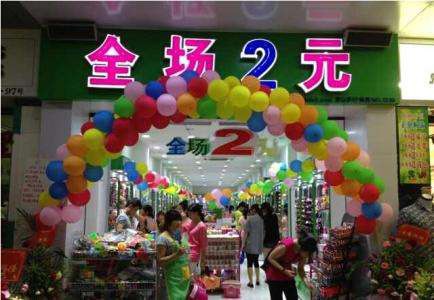
The writing says: quánchǎng 2 yuán 全场2元 ("everything in the store for 2 yuan"). Naturally, not everything in the store costs exactly 2 yuan (= 28¢ US). The idea is that everything in the store is cheap, and most of it does cost around 2 yuan or less.
Of course, this reminds us of "dollar stores", e.g., "Dollar Tree", in America (and 100 yen [a little less than a dollar] stores in Japan). I've been in many of them, and am always amazed at what you can find there for a dollar or less. I simply don't understand how such stores can make a profit, but many of them actually thrive.
Several of my students said that they frequented these 2 yuan stores when they were in middle school and high school and that they carried "decorative stuff and things for women", as well as "stationary and girl’s accessories 🙈 and "hairpins, sticky hooks, and other sundries". Some even said that they remembered when they were in elementary school there were yīyuán diàn 一元店 ("1 yuan stores"), but they don't exist any longer. They also remarked that you don't see many 2 yuan stores anymore, and that they may be found mainly in rural areas.
Nowadays people think that èr yuán diàn 二元店 ("2 yuan store") only have "cheap and poor-quality products". You do, however, find some shí yuán diàn 十元店 ("ten yuan stores") — such stores even passed through 4 yuan and 8 yuan stages — that are more, ahem, "respectable". Other reasons for the withering away of the 2 yuan stores that were given are "flourishing of the economy", "increasing price level", "the development of online shopping", and "the policy of so-called 'decentralization of the non-capital functions of Beijing'".
Still, my students remember the old days when they used to go to these 2 yuan stores, and even fondly recall the loud announcements of the attendants:
"Emergency demolition! Everything must go! Crazy sale! 2 yuan! 2 yuan! Everything for only 2 yuan! If you don't buy now you'll lose out! If you don't buy now you'll be a fool!"
Here are some scenes from inside a real Zhenhua Mart, which may be found at many locations in North China today:
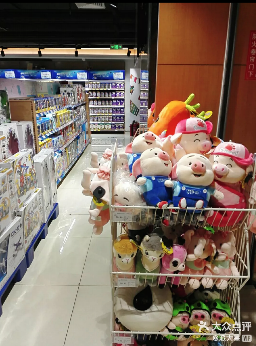
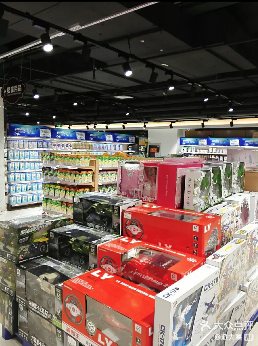
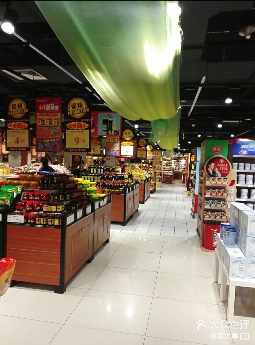
Clearly not a 2 yuan 元 store!
So how do we square the primary symbolism of the 2 yuan 元 logo with the reality of Zhenhua Mart supermarkets today? I think that Zhenhua may have started out as a 2 yuan 元 store, and they cherish their humble origins. Even if they didn't start out as a 2 yuan 元 store, they may aspire to the ideal of such stores in making goods available at the lowest possible prices.
Reading
"It's a time sex thing, baby" (8/8/07)
[Thanks to Yixue Yang, Yijie Zhang, Chenfeng Wang, Lin Zhang, Qing Liao, Tong Wang, Zeyao Wu, and Xiuyuan Mi]
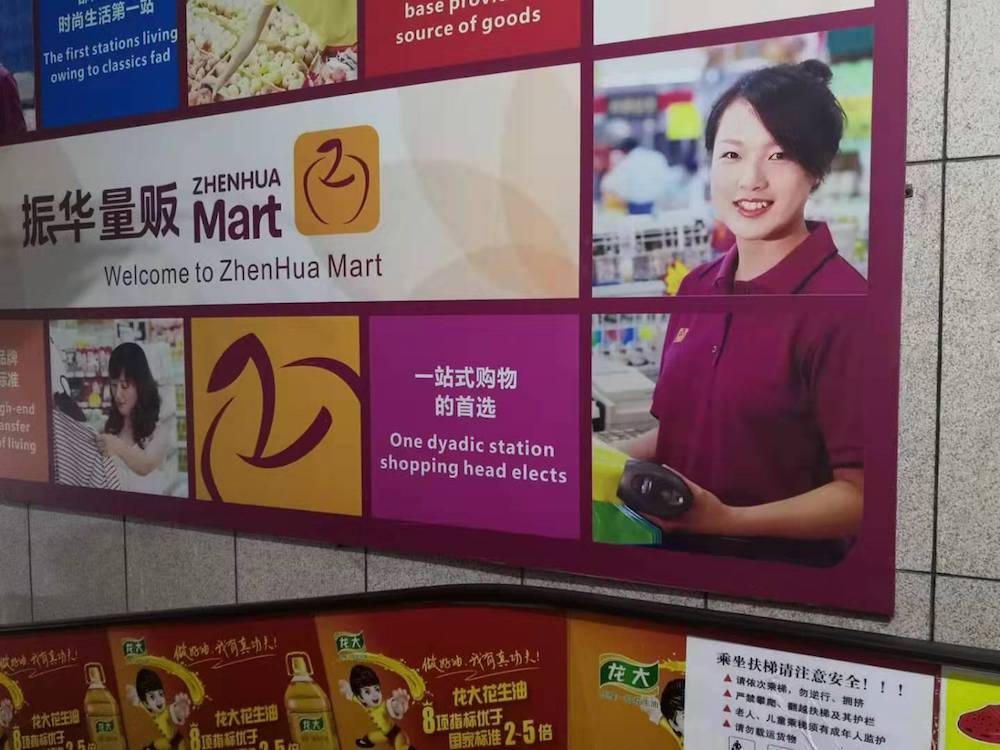
cameron said,
August 24, 2019 @ 3:05 am
Did I miss something, or did you never get around to explaining how the apparatus the woman on the poster has in her left hand fits into the story?
Of course, before there were "dollar stores" in the US, Woolworth's was known as a "five and ten cent store", or "five-and-dime" – or, more formally "5¢ & 10¢ store". I'm old enough to remember shopping at Woolworth's, but the days when the "five and dime" designation was accurate were well before my time.
B.Ma said,
August 24, 2019 @ 3:14 am
Yes, I think someone is very proud of themselves for coming up with a logo that looks like an apple, ZH and a 2 (almost) in a circle.
In Hong Kong we used to have \$10 shops, then they became \$12 shops (everything \$12) then they became "fixed price marts". They seem to import things directly from 100 yen shops (now 108 yen and soon 110 yen with the sales tax) and now they stick up charts showing the HKD price they charge based on the Japanese price which is usually printed on the packaging, instead of wasting resources on creating HKD labels for every item.
In Australia I recall visiting \$1 shops which later became \$2 shops.
In the UK, we have Poundland, 99p stores, then 98p, 97p, … stores. Many of these don't survive for long.
Philip Taylor said,
August 24, 2019 @ 4:45 am
And in Poundland (unless something has changed since I last visited one), everything is exactly £1-00, unlike Victor's 2-yuan stores, which is why the assistants in Poundland tend to look at one with a mixture of incredulity and amusement if one asks "How much is this ?" …
Victor Mair said,
August 24, 2019 @ 7:08 am
It's interesting that in Poundland stores the prices seem to have gone down over the years:
"Poundland, 99p stores, then 98p, 97p, … stores."
Victor Mair said,
August 24, 2019 @ 7:20 am
@cameron
Yes, you missed something. The explanation of what the assistant has in her left hand is given later on in the narrative, but it is implicit, not explicit. I wanted to challenge LL readers in the ways of decoding Chinglish just a bit, in case they wish to take up the trade. It's sort of like a detective story, you know. There are clues here and there. Add them up and the crime is solved. Elementary, my dear Watson.
Michèle Sharik Pituley said,
August 24, 2019 @ 1:55 pm
Isn't it just a scanner in her left hand??
Jonathan Smith said,
August 24, 2019 @ 3:02 pm
This is a machine translation issue (clear given "head elects" for shǒuxuǎn 首选, etc.); for some reason 式 is being treated as "dyadic". Some random googlable examples:
俄军事公司供应虎式装甲车用于奥运安保 "The dyadic tiger armoured vehicle the russia military affairs company is supplied is used for olympic games abo. "
幕后配角大揭密,冯式电影营销霸主地位不可撼动 "Backstage , the supporting role exposes a secret greatly , dyadic feng film camp sells a hegemony being not allowed to shake .
Dunno why tho. B/c 並矢式 ‘dyadic’ itself contains 式?
Peter Taylor said,
August 25, 2019 @ 1:56 am
"The first stations living owing to classics fad" in the top-left of the photo also draws my attention. Would I be correct in guessing that the gist is "We're the best because we've outlived all our competitors"?
Chas Belov said,
August 25, 2019 @ 2:54 am
The Japanese 100 yen stores have made their way to the US. There are multiple Daiso stores in the Bay Area, and Japantown also has an Ichiban Kan which is mostly, but not entirely, 100 yen before currency conversion inflation.
Then there's the opposite of the dollar store, 99¢ and up at 40-22 82nd Street, Queens including the reassurance Yes! We do carry over 99¢ items.
John Swindle said,
August 25, 2019 @ 5:20 am
I know! I know! It's the sea cucumbers you mentioned! She's holding a ¥2 automatic sea cucumber. No, that can't be it either.
Victor Mair said,
August 25, 2019 @ 7:57 am
@Peter Taylor
"We're the best because we've outlived all our competitors"?
No, it means "First stop for fashionable living".
Victor Mair said,
August 25, 2019 @ 11:16 pm
"for some reason"
A reason: 二元 <-- > dyadic
maidhc said,
August 26, 2019 @ 4:08 am
"Emergency demolition! Everything must go! Crazy sale! 2 yuan! 2 yuan! Everything for only 2 yuan! If you don't buy now you'll lose out! If you don't buy now you'll be a fool!"
Sounds like the "blue light specials" they used to have at K-Mart.
K-Marts are really thinning out around here. There used to be two within a 15 minute drive. Now there are two within a 45 minute drive.
I haven't been to one in years, so I don't know if they still have "blue light specials".
BZ said,
August 26, 2019 @ 1:53 pm
There is a 79 cent store near where I work which was a 69 cent store not too long ago. Either way, I was surprised that stores with limits below 99 cents still existed when I first saw it. Though I've never found anything useful there.
Jonathan Smith said,
August 26, 2019 @ 2:28 pm
Prof. Mair — sorry, I mean “dyadic” is being introduced due to the syllable shi4 式, apparently in particular when it is not part of a larger word which the engine recognizes. So no connection to er4yuan2 二元. For example, even better than the above, from
http://dict.cn/dyadic#def
Where can Beijing be arrived at dyadic pure Guangdong marmite meal? :D :D
北京哪里能吃到地道的粤式砂锅饭?
Such are the wonders of Chinglish… though I suppose this new machine-translationese might not even deserve the name …
번하드 said,
August 26, 2019 @ 8:07 pm
@Chas Belov:
Oh, funny. "Daiso", for me, sounds like Korean "다 있어" (da isseo, we have everything)
http://www.daiso.co.kr/ — is it that one?
Back in Korea a few years ago, there was another chain called "다판다" (da panda, we sell everything), but that seems to have been supplanted by https://www.edapanda.co.kr/ .
liuyao said,
August 27, 2019 @ 9:19 am
It does seem that Jonathan Smith was right, dyadic comes from the single character 式. Either in the sense in physics (dyadic as an expression formed from two vectors) or in mathematics (fraction whose denominator is a power of 2), there's no appearance of 二元. On the other hand, if given 二元, I'd think dualism of Descartes, or to mean "two variables" (e.g. 二元一次方程 = first-degree equation(s) in two variables).
Victor Mair said,
August 27, 2019 @ 7:01 pm
The lexeme "yízhàn shì 一站式" ("one stop style") receives 190,000,000 ghits and has its own Baidu encyclopedia entries (here and here).
With such an enormous data base to train on, it's no wonder that all the major online machine translators get it right:
=====
Google Translate: "one stop".
Microsoft Translator: "one-stop shop".
Baidu Fanyi: "one-stop", with 29 example sentences, all correctly translating "yízhàn shì 一站式" as "one-stop", "one-stop shopping", etc.
=====
The composition of the lexeme "yízhàn shì 一站式" is easy to analyze and understand, both for humans and for machines. The "yízhàn 一站" part all too obviously means "one stop" and the "shì 式" part means "formula; pattern; type; style; ceremony; form; model", so together they mean "one-stop style [shopping]", i.e., "one-stop [shopping]").
The construction of "yízhàn shì 一站式" ("one stop type / style") is closely similar to that of "yīcì xìng 一次性" ("having the nature of a single use", which is to say, "for single use", or more simply, "disposable"). I discussed this collocation in the reading, "It's a time sex thing, baby" (8/8/07) a dozen years ago.
Jonathan Smith said,
August 28, 2019 @ 10:07 pm
^ yep, this is the product of an awful and hopefully long-since retired engine (old dict.cn?) and definitely not a person. Quite aside from "一站式" > "one dyadic station", atrocities like "首选" > "head elects" have not been seen for ages on the likes of Google.
Looks like my link above now points to newer results; at time of writing the examples below are visible at http://fy.tingclass.net/w/dyadic:
痉挛_式_胎动 > "dyadic fetal movement of spasm"
虎_式_装甲车 > "dyadic tiger armoured vehicle
地毯_式_搜索 > "dyadic reconnaissance of carpet"
冯_式_电影 > "dyadic feng film"
阅读、规律、代数_式_ > "reading , law , algebra are dyadic"
Victor Mair said,
August 29, 2019 @ 5:40 am
Please document the machine translation origin of "首选" > "head elects". Which machine translator did it come from? Better yet, please document the machine translation origin of "首选" > "head elects" and "一站式" > "one dyadic station" in the same sentence.